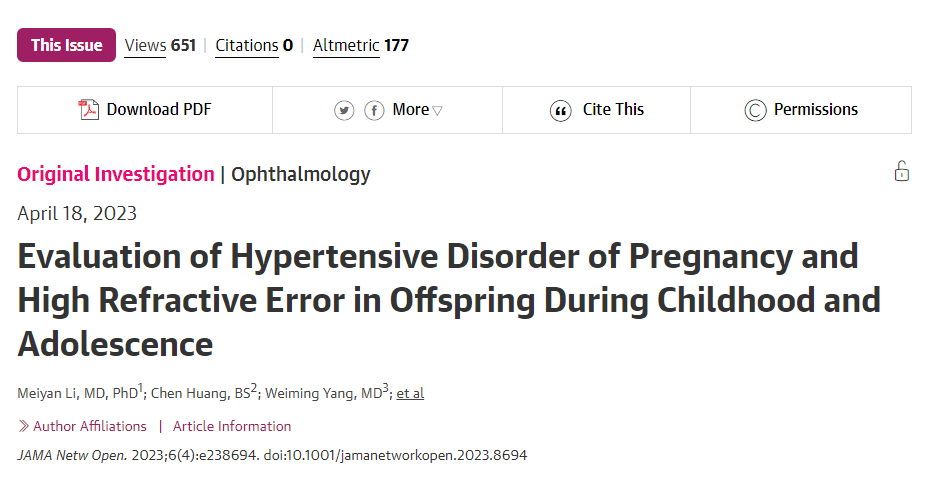On April 18th, researchers from Fudan University published “Evaluation of Hypertensive Disorder of Pregnancy and High Refractive Error in Offspring During Childhood and Adolescence” online in the JAMA Network Open, a sub issue of the Journal of the American Medical Association. They found that gestational hypertension is associated with refractive errors in offspring (myopia, hyperopia, astigmatism).

Refractive error is the most common clinical problem in ophthalmology at present. High refractive error, such as high myopia, often causes serious visual impairment and affects visual health, but its etiology is still unclear. People have found that, as one of the most common complications of pregnancy, gestational hypertension may be related to abnormal visual development and some eye related diseases in offspring. But it is unclear whether gestational hypertension affects and to what extent it affects the occurrence of high refractive errors in offspring during adolescence.
To this end, the team carried out a large sample cohort study based on birth registration data to assess the relationship between maternal hypertensive disorder complicating pregnancy and its subtypes, and the overall risk of high refractive error and subtypes in the offspring.
Research has found that mothers with gestational hypertension have an increased risk of developing high refractive errors (hyperopia, myopia, astigmatism) in their offspring before the age of 18 (hazard ratio 1.39, 95% confidence interval 1.31-1.49). Mothers with early-onset and severe preeclampsia have a higher risk of developing high refractive errors in their offspring (hazard ratio 2.59, 95% confidence interval 2.17-3.08). This study suggests that if a mother is diagnosed with hypertension before or during pregnancy, it is recommended that their children undergo eye examinations as soon as possible, which has guiding significance for the prevention and treatment of high myopia.
Evaluation of Hypertensive Disorder of Pregnancy and High Refractive Error in Offspring During Childhood and Adolescence
Journal: JAMA Network Open
Abstract:
Importance Growing evidence indicates that adverse prenatal or intrauterine environments might contribute to the development of high refractive error (RE) later in life. However, the association of maternal hypertensive disorder of pregnancy (HDP) with high RE in offspring during childhood and adolescence remains unknown.
Objective To investigate the association between maternal HDP and overall and type-specific high REs in offspring in childhood and adolescence.
Design, Setting, and Participants This nationwide population-based cohort study included live-born individuals born in Denmark from 1978 to 2018 in the Danish national health registers. Follow-up started at the date of birth and ended at the date of RE diagnosis, 18th birthday, death, emigration, or December 31, 2018, whichever came first. Data analyses were conducted from November 12, 2021, through June 30, 2022.
Exposures Maternal HDP (n = 104 952), including preeclampsia or eclampsia (n = 70 465) and hypertension (n = 34 487).
Main Outcomes and Measures The main outcomes were the first occurrence of high RE (hyperopia, myopia, and astigmatism) in offspring. A Cox proportional hazards regression model was used to examine the association between maternal HDP and risk of high RE in offspring from birth until age 18 years, adjusting for multiple potential confounders.
Results This study included 2 537 421 live-born individuals, 51.30% of whom were male. During the follow-up of up to 18 years, 946 offspring of 104 952 mothers with HDP (0.90%) and 15 559 offspring of 2 432 469 mothers without HDP (0.64%) were diagnosed with high RE. The cumulative incidence of high RE was higher in the exposed cohort (1.12%; 95% CI, 1.05%-1.19%) than in the unexposed cohort (0.80%; 95% CI, 0.78%-0.81%) at 18 years of age (difference: 0.32%; 95% CI, 0.25%-0.40%). Offspring born to mothers with HDP had a 39% increased risk of overall high RE (hazard ratio [HR], 1.39; 95% CI, 1.31-1.49). Sibling-matched analysis revealed an increased risk of overall high RE in half siblings (HR, 1.21; 95% CI, 1.05-1.39) and full siblings (HR, 1.15; 95% CI, 0.99-1.34), but the difference was not significant for the latter. The elevated risks were observed for hypermetropia (HR, 1.41; 95% CI, 1.30-1.52), myopia (HR, 1.30; 95% CI, 1.10-1.53), and astigmatism (HR, 1.45; 95% CI, 1.22-1.71). The increased risk of high RE persisted among offspring aged 0 to 6 years (HR, 1.51, 95% CI, 1.38-1.65), 7 to 12 years (HR, 1.28; 95% CI, 1.11-1.47), and 13 to 18 years (HR, 1.16; 95% CI, 0.95-1.41), but the difference was not significant for the oldest group. When considering both timing of diagnosis and severity of maternal preeclampsia, the highest risk was observed in offspring prenatally exposed to early-onset and severe preeclampsia (HR, 2.59; 95% CI, 2.17-3.08).
Conclusions and Relevance In this cohort study of the Danish population, maternal HDP, especially early-onset and severe preeclampsia, was associated with an increased risk of high RE in offspring during childhood and adolescence. These findings suggest that early and regular RE screening should be recommended for children of mothers with HDP.





